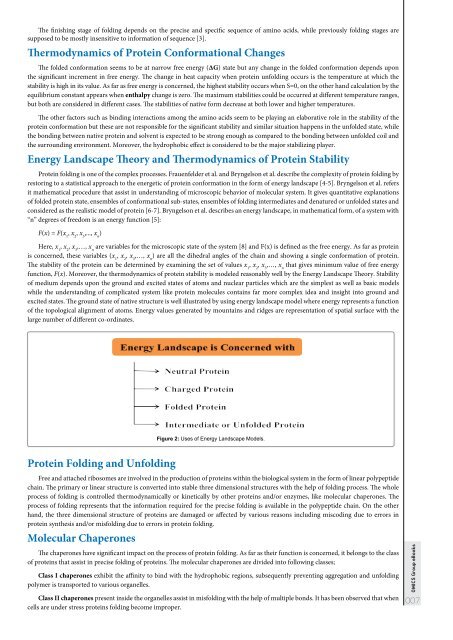Create successful ePaper yourself
Turn your PDF publications into a flip-book with our unique Google optimized e-Paper software.
The f<strong>in</strong>ish<strong>in</strong>g stage of fold<strong>in</strong>g depends on the precise and specific sequence of am<strong>in</strong>o acids, while previously fold<strong>in</strong>g stages are<br />
supposed to be mostly <strong>in</strong>sensitive to <strong>in</strong>formation of sequence [3].<br />
Thermodynamics of Prote<strong>in</strong> Conformational Changes<br />
The folded conformation seems to be at narrow free energy (ΔG) state but any change <strong>in</strong> the folded conformation depends upon<br />
the significant <strong>in</strong>crement <strong>in</strong> free energy. The change <strong>in</strong> heat capacity when prote<strong>in</strong> unfold<strong>in</strong>g occurs is the temperature at which the<br />
stability is high <strong>in</strong> its value. As far as free energy is concerned, the highest stability occurs when S=0, on the other hand calculation by the<br />
equilibrium constant appears when enthalpy change is zero. The maximum stabilities could be occurred at different temperature ranges,<br />
but both are considered <strong>in</strong> different cases. The stabilities of native form decrease at both lower and higher temperatures.<br />
The other factors such as b<strong>in</strong>d<strong>in</strong>g <strong>in</strong>teractions among the am<strong>in</strong>o acids seem to be play<strong>in</strong>g an elaborative role <strong>in</strong> the stability of the<br />
prote<strong>in</strong> conformation but these are not responsible for the significant stability and similar situation happens <strong>in</strong> the unfolded state, while<br />
the bond<strong>in</strong>g between native prote<strong>in</strong> and solvent is expected to be strong enough as compared to the bond<strong>in</strong>g between unfolded coil and<br />
the surround<strong>in</strong>g environment. Moreover, the hydrophobic effect is considered to be the major stabiliz<strong>in</strong>g player.<br />
Energy Landscape Theory and Thermodynamics of Prote<strong>in</strong> Stability<br />
Prote<strong>in</strong> fold<strong>in</strong>g is one of the complex processes. Frauenfelder et al. and Bryngelson et al. describe the complexity of prote<strong>in</strong> fold<strong>in</strong>g by<br />
restor<strong>in</strong>g to a statistical approach to the energetic of prote<strong>in</strong> conformation <strong>in</strong> the form of energy landscape [4-5]. Bryngelson et al. refers<br />
it mathematical procedure that assist <strong>in</strong> understand<strong>in</strong>g of microscopic behavior of molecular system. It gives quantitative explanations<br />
of folded prote<strong>in</strong> state, ensembles of conformational sub-states, ensembles of fold<strong>in</strong>g <strong>in</strong>termediates and denatured or unfolded states and<br />
considered as the realistic model of prote<strong>in</strong> [6-7]. Bryngelson et al. describes an energy landscape, <strong>in</strong> mathematical form, of a system with<br />
“n” degrees of freedom is an energy function [5]:<br />
F(x) = F(x 1<br />
, x 2<br />
, x 3<br />
,..., x n<br />
)<br />
Here, x 1<br />
, x 2<br />
, x 3<br />
,…, x n<br />
are variables for the microscopic state of the system [8] and F(x) is def<strong>in</strong>ed as the free energy. As far as prote<strong>in</strong><br />
is concerned, these variables (x 1<br />
, x 2<br />
, x 3<br />
,…, x n<br />
) are all the dihedral angles of the cha<strong>in</strong> and show<strong>in</strong>g a s<strong>in</strong>gle conformation of prote<strong>in</strong>.<br />
The stability of the prote<strong>in</strong> can be determ<strong>in</strong>ed by exam<strong>in</strong><strong>in</strong>g the set of values x 1<br />
, x 2<br />
, x 3<br />
,…, x n<br />
that gives m<strong>in</strong>imum value of free energy<br />
function, F(x). Moreover, the thermodynamics of prote<strong>in</strong> stability is modeled reasonably well by the Energy Landscape Theory. Stability<br />
of medium depends upon the ground and excited states of atoms and nuclear particles which are the simplest as well as basic models<br />
while the understand<strong>in</strong>g of complicated system like prote<strong>in</strong> molecules conta<strong>in</strong>s far more complex idea and <strong>in</strong>sight <strong>in</strong>to ground and<br />
excited states. The ground state of native structure is well illustrated by us<strong>in</strong>g energy landscape model where energy represents a function<br />
of the topological alignment of atoms. Energy values generated by mounta<strong>in</strong>s and ridges are representation of spatial surface with the<br />
large number of different co-ord<strong>in</strong>ates.<br />
Figure 2: Uses of Energy Landscape Models.<br />
Prote<strong>in</strong> Fold<strong>in</strong>g and Unfold<strong>in</strong>g<br />
Free and attached ribosomes are <strong>in</strong>volved <strong>in</strong> the production of prote<strong>in</strong>s with<strong>in</strong> the biological system <strong>in</strong> the form of l<strong>in</strong>ear polypeptide<br />
cha<strong>in</strong>. The primary or l<strong>in</strong>ear structure is converted <strong>in</strong>to stable three dimensional structures with the help of fold<strong>in</strong>g process. The whole<br />
process of fold<strong>in</strong>g is controlled thermodynamically or k<strong>in</strong>etically by other prote<strong>in</strong>s and/or enzymes, like molecular chaperones. The<br />
process of fold<strong>in</strong>g represents that the <strong>in</strong>formation required for the precise fold<strong>in</strong>g is available <strong>in</strong> the polypeptide cha<strong>in</strong>. On the other<br />
hand, the three dimensional structure of prote<strong>in</strong>s are damaged or affected by various reasons <strong>in</strong>clud<strong>in</strong>g miscod<strong>in</strong>g due to errors <strong>in</strong><br />
prote<strong>in</strong> synthesis and/or misfold<strong>in</strong>g due to errors <strong>in</strong> prote<strong>in</strong> fold<strong>in</strong>g.<br />
Molecular Chaperones<br />
The chaperones have significant impact on the process of prote<strong>in</strong> fold<strong>in</strong>g. As far as their function is concerned, it belongs to the class<br />
of prote<strong>in</strong>s that assist <strong>in</strong> precise fold<strong>in</strong>g of prote<strong>in</strong>s. The molecular chaperones are divided <strong>in</strong>to follow<strong>in</strong>g classes;<br />
Class I chaperones exhibit the aff<strong>in</strong>ity to b<strong>in</strong>d with the hydrophobic regions, subsequently prevent<strong>in</strong>g aggregation and unfold<strong>in</strong>g<br />
polymer is transported to various organelles.<br />
Class II chaperones present <strong>in</strong>side the organelles assist <strong>in</strong> misfold<strong>in</strong>g with the help of multiple bonds. It has been observed that when<br />
cells are under stress prote<strong>in</strong>s fold<strong>in</strong>g become improper.<br />
OMICS Group eBooks<br />
007



